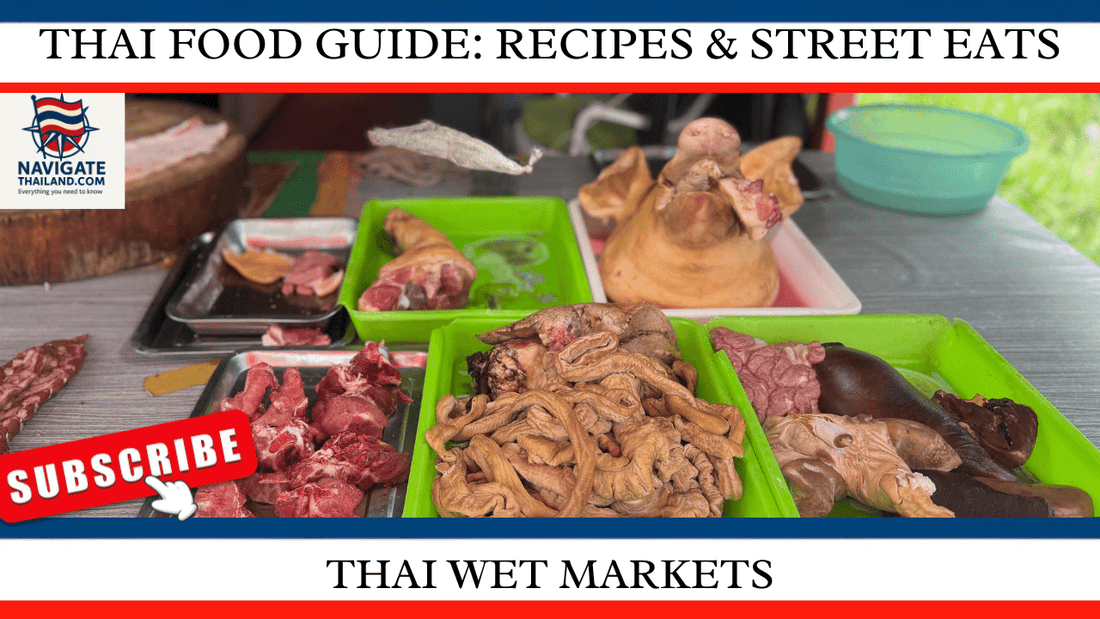
Wet Markets in Thailand: Everything You Need to Know
Share
Thailand’s wet markets are bustling hubs of local life, vibrant centres where locals and tourists alike can experience authentic Thai culture. From fresh produce and meats to exotic animals, seafood, and a dazzling array of street food, wet markets in Thailand offer a glimpse into the daily lives of Thai people and their rich culinary traditions. For travellers looking to immerse themselves in local culture, a visit to one of these markets is an absolute must.
In this detailed guide, we’ll explore everything you need to know about Thailand’s wet markets—what you can buy, where they are located, unusual and exotic animals on sale, the average price of items, and practical tips for navigating these vibrant, sensory-overloading spaces.
What Are Wet Markets?
Wet markets are open-air or partially covered markets that primarily sell fresh produce, meat, seafood, and other perishable goods. They get their name from the wet floors, often soaked with water used to keep fish and produce fresh and to clean the areas. Wet markets are essential to the everyday life of many Thai people, offering affordable, fresh, and local ingredients for home cooking.
Unlike supermarkets, wet markets provide a sensory experience unlike any other, with the sight of glistening seafood, the smell of fresh herbs, and the sound of vendors energetically calling out to passersby. Thailand’s wet markets are renowned for their variety and quality of products, and they offer an excellent opportunity for travellers to experience Thai food culture up close.
What You Can Buy at Wet Markets in Thailand
Wet markets in Thailand are famous for their diverse selection of goods. Whether you’re looking for the freshest seafood or exotic fruits, these markets have it all.
1. Fresh Seafood
Thailand’s coastline provides an abundance of fresh seafood, and wet markets are often stocked with the day’s catch. You’ll find a wide variety of fish, shellfish, crustaceans, and even exotic options like horseshoe crabs and mud crabs. Some seafood items that are particularly popular include:
• Shrimp (both freshwater and saltwater varieties)
• Squid and octopus
• Crabs (blue crabs, mud crabs, and soft-shell crabs)
• Fish (barramundi, tilapia, snapper, and catfish)
• Oysters, clams, and mussels
Seafood prices can vary depending on the freshness and rarity of the items. For example, a kilogram of fresh shrimp might cost around 300-500 THB ($10-16 AUD), while premium items like large mud crabs or live lobsters can cost significantly more.
Fun Fact: Thailand is a major exporter of seafood, and some of the seafood you find in wet markets is so fresh that it was caught just a few hours earlier!
2. Meat and Poultry
One of the most common sights at Thai wet markets is the wide variety of meats available, including chicken, pork, beef, and duck. Many markets also sell whole chickens and ducks, as well as cuts like liver, feet, and heads, which are commonly used in traditional Thai dishes.
Pork is one of the most popular meats in Thailand, and you’ll find it sold in various forms—from fresh cuts and minced pork to sausages and cured meats. You may also come across exotic meats, such as frogs, eels, and occasionally snake meat, depending on the region.
On average, pork and chicken cost about 120-150 THB ($5-6 AUD) per kilogram, while beef is slightly more expensive at around 180-250 THB ($7-10 AUD) per kilogram.
3. Exotic Animals
Wet markets in Thailand are infamous for selling some unusual and exotic animals that aren’t typically found in Western markets. While not all travellers may feel comfortable with these offerings, it’s an interesting and culturally significant aspect of Thai markets. Some of the more exotic animals you might encounter include:
• Turtles
• Frogs (often sold live)
• Insects (crickets, grasshoppers, silk worms)
• Eels and snakes
• Birds (including live ducks, chickens, and sometimes exotic birds)
Certain wet markets, particularly in rural areas, may also have wild animals for sale, though this practice is becoming less common due to wildlife protection laws and increasing awareness about conservation.
4. Fruits and Vegetables
Thailand is blessed with a tropical climate that supports the growth of a wide range of exotic fruits and vegetables. Thai wet markets are an explosion of colour, with stalls brimming with fresh produce. Some must-try fruits and vegetables include:
• Mangoes: Available year-round but especially abundant during mango season (March to June). Prices range from 40-100 THB ($2-4 AUD) per kilogram.
• Durian: Known as the “king of fruits,” durian is famous for its strong smell and creamy texture. Prices vary depending on the variety and size, but expect to pay around 150-400 THB ($6-16 AUD) per kilogram.
• Dragon fruit: A beautiful fruit with bright pink skin and white or red flesh dotted with tiny seeds. Typically costs 40-60 THB ($2-3 AUD) per kilogram.
• Papaya: A key ingredient in the popular Thai dish som tam (papaya salad), papaya is available in abundance for around 20-30 THB ($1 AUD) per kilogram.
• Herbs and Spices: Fresh lemongrass, galangal, kaffir lime leaves, and Thai basil are essential for cooking authentic Thai food, and you’ll find plenty of these in every wet market.
Fun Fact: Thai markets offer exotic fruits like rambutan, mangosteen, and longan, which are not only delicious but also packed with nutrients!
5. Thai Street Food
Wet markets are also home to some of the best street food in Thailand. As you wander through the stalls, you’ll be tempted by the aroma of freshly cooked dishes like pad Thai, grilled satay skewers, and sticky rice with mango. Vendors sell everything from quick snacks to full meals, making it easy to grab a bite as you shop.
Here are some popular street food items commonly found in or near wet markets:
• Pad Thai: Stir-fried noodles with shrimp or chicken, tofu, and a tangy tamarind sauce. Prices usually range from 40-60 THB ($2-3 AUD) per plate.
• Som Tam (Papaya Salad): A spicy and tangy salad made from shredded green papaya, fish sauce, lime, and chilli. Prices range from 30-50 THB ($1.50-2.50 AUD).
• Moo Ping (Grilled Pork Skewers): Delicious marinated pork skewers grilled over charcoal. Prices typically range from 10-20 THB ($0.50-1 AUD) per skewer.
• Khanom Buang (Thai Crepes): Sweet or savoury Thai crepes filled with coconut, egg yolk, and other ingredients. Prices are usually 10-20 THB ($0.50-1 AUD) each.
Where Are the Wet Markets Located?
Thailand is home to hundreds of wet markets, ranging from small neighbourhood stalls to large market complexes. You’ll find wet markets in every city and rural town, but some stand out for their size, variety, and uniqueness. Here are some of the most notable wet markets in Thailand:
1. Or Tor Kor Market, Bangkok
Or Tor Kor Market is located near the famous Chatuchak Weekend Market in Bangkok and is renowned for its high-quality produce and seafood. It’s one of the cleanest and most well-organised wet markets in the country, offering everything from fresh fruits and vegetables to premium seafood and meats. While prices here tend to be slightly higher, the quality of the products is unmatched.
2. Khlong Toei Market, Bangkok
Khlong Toei Market is Bangkok’s largest wet market and offers a gritty, authentic shopping experience. It’s a bustling, chaotic place where you can find just about anything—fresh seafood, meat, vegetables, fruits, and even live animals. This market is a must-visit for travellers looking to experience an unfiltered view of local life.
3. Chiang Mai Gate Market, Chiang Mai
Located just outside the old city walls of Chiang Mai, this market is a favourite among locals and tourists alike. Chiang Mai Gate Market is particularly famous for its vibrant night market, where vendors set up street food stalls offering an array of Thai dishes.
4. Talad Rom Hub (Maeklong Railway Market)
Located about 80 kilometres southwest of Bangkok, the Maeklong Railway Market is one of Thailand’s most unique wet markets. The market is set up along a railway line, and vendors quickly move their stalls aside when a train comes through. It’s a fun, quirky experience that has become a popular attraction for travellers.
5. Warorot Market, Chiang Mai
Warorot Market, also known as Kad Luang, is one of Chiang Mai’s oldest and most famous wet markets. It’s a multi-level market offering fresh produce, meats, seafood, and clothing. The market is particularly known for its selection of northern Thai delicacies and snacks.
6. Damnoen Saduak Floating Market, Ratchaburi
While not a traditional wet market, Damnoen Saduak Floating Market is an iconic market where vendors sell goods from boats on the water. You’ll find fresh produce, fruits, and Thai snacks being sold from the canals, offering a unique shopping experience for visitors.
Weird and Exotic Animals at Wet Markets
One of the more controversial aspects of wet markets in Thailand is the sale of exotic animals. While not all markets sell such items, you may come across some unusual offerings at smaller, rural markets or in specific regions. Some examples of exotic animals found in wet markets include:
• Turtles: Used in traditional medicine and sometimes sold as pets or for consumption.
• Frogs: Considered a delicacy in many parts of Thailand, especially in the north. Live frogs are often sold for cooking in traditional dishes like tom kha frog soup.
• Snakes: While less common, some markets sell snakes for consumption. Snake meat is believed to have medicinal properties in certain regions.
• Birds: In some rural markets, you may find live birds, including wild-caught species, though this practice is illegal in some areas due to wildlife protection laws.
• Insects: Insects like crickets, silkworms, and grasshoppers are commonly sold at wet markets, particularly in northern Thailand. Fried insects are a popular street food and are often seasoned with salt or chilli powder.
Important Note: While exotic animal sales are part of Thailand’s market culture, it is essential to avoid supporting illegal wildlife trade. Many of these animals are protected, and the sale of certain species may be illegal under Thailand’s wildlife conservation laws.
Average Prices at Wet Markets
Wet markets in Thailand are known for their affordable prices, making them an excellent option for locals and travellers alike. Below are some average prices for common items at wet markets:
• Fruits: 30-100 THB ($1-4 AUD) per kilogram, depending on the fruit and season.
• Vegetables: 20-40 THB ($1-2 AUD) per kilogram.
• Meat (chicken, pork, beef): 120-250 THB ($5-10 AUD) per kilogram.
• Seafood (shrimp, fish, squid): 200-500 THB ($8-16 AUD) per kilogram.
• Street Food: 30-60 THB ($1.50-3 AUD) per plate or item.
Prices can vary depending on the location of the market, with urban markets often being slightly more expensive than rural ones. However, no matter where you are, wet markets in Thailand generally offer excellent value for money.
Practical Tips for Visiting Wet Markets
1. Bring Cash: Most vendors at wet markets only accept cash, so be sure to bring small bills and coins for easy transactions.
2. Bargain Politely: While prices at wet markets are already reasonable, haggling is a common practice in Thailand. Just be polite and respectful when negotiating.
3. Wear Comfortable Shoes: Wet markets can be sprawling and involve a lot of walking. The floors can also be slippery, so wear shoes with good grip.
4. Mind the Smells: Wet markets can have strong odours, particularly in the seafood and meat sections. If you have a sensitive nose, you might want to bring a face mask.
5. Go Early: If you want to experience the freshest produce and avoid the crowds, it’s best to visit wet markets in the early morning.
Conclusion
Thailand’s wet markets are vibrant, chaotic, and full of life. They offer a true taste of local culture and provide travellers with an authentic experience of daily Thai life. Whether you’re there to buy fresh ingredients, sample delicious street food, or simply explore, visiting a wet market is a must on any trip to Thailand. With their affordable prices, variety of products, and unique atmosphere, Thailand’s wet markets remain an essential part of the country’s culinary and cultural fabric.
References:
1. National Geographic – “Markets of Southeast Asia: A Cultural and Culinary Journey”
2. Tourism Authority of Thailand – “Exploring Thailand’s Wet Markets”
3. World Wildlife Fund (WWF) – “Wildlife and Conservation in Thailand’s Markets”
4. Lonely Planet – “Top Wet Markets to Visit in Thailand”
5. Bangkok Post – “The Future of Wet Markets in a Changing Thailand”
Read more of our Thailand blog series:
Thai Food Guide:Traditional Recipes and Street Eats
Everything Travellers Need to know
Thailand travel ebooks and language guides
Thailand Travel Apparel & Souvenir Gifts
Subscribe to our YouTube channel Navigate Thailand to see our most popular Thailand travel blogs turned into videos:
Navigate Thailand YouTube channel


















































































































































